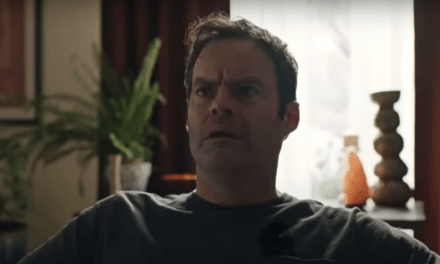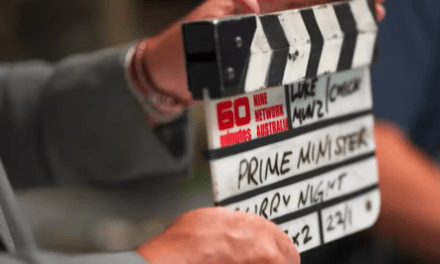In the most recent episode of Matt Berry’s sitcom Toast of London, the titular thespian demonstrated a lamentable (though characteristic) disengagement from his profession by several times announcing: ‘I never watch the television. Though I have heard that Breaking Bad is very good.’
Ah, Breaking Bad; I’ve only seen the episodes I’ve had to teach, so maybe I’m the one who’s disengaged. To be honest, I’d much rather watch a bit of ‘old’ TV. Quite when TV becomes ‘old’ is up for debate, and probably dependent on the age of the watcher. I namechecked The X-Files in a seminar the other day, and was perplexed by the lack of recognition in my students’ sleepy eyes until I realised that most of them were probably around seven years old when it came off the air. That certainly gives one pause, but for me the appeal of ‘old’ TV is that it presents a time capsule of days – and broadcasting habits – gone by. I don’t just mean in terms of societal change, or what telly teaches us about ‘how we used to be’; that’s only one of numerous didactic possibilities, though I admit I’d rather learn about changing historical attitudes this way than by watching Mad Men. No, it’s more the case that, as a television historian, I automatically perk up when any old TV comes on – though the duration and intensity of my interest are usually dependent on the extent to which I engage with the programme itself.
My current archive telly of choice is Rumpole of the Bailey, originally produced by Thames Television over seven series between 1978 and 1992 (plus a 1980 special). I admit that the programme passed me by at the time; I was too young to enjoy series one to three, and more likely to have been out discovering the joys of cider when the later series aired. However, Rumpole is currently enjoying a series of repeats courtesy of Freeview channel Drama, whose screening of four episodes back-to-back helps ease me into the weekend of a Saturday morning.
Drama
Rumpole began life not at Thames, but as a 1975 Play for Today, starring Leo McKern as ageing barrister Horace Rumpole; a claret-drinking, Wordsworth-quoting ‘Old Bailey hack’, whose days of fame and glory (and the oft-recalled Penge bungalow murders, which he conducted alone – without a leader) now lie in the distant past, and who only appears for the defence. Author John Mortimer, who drew upon his own and his father’s experiences at the Bar when creating the character, had originally envisaged Michael Hordern in the role, but his initial reservations regarding the casting of McKern were soon dispelled by the Australian actor’s robust yet sensitive interpretation, which made good use of his sonorous voice both for Rumpole’s courtroom appearances and the reflective internal monologues which formed a major part of the narrative. The original play ‘Rumpole of the Bailey’ ostensibly centred round Horace’s defence of a teenager accused of a stabbing outside Lord’s cricket ground; the case is won when Rumpole demonstrates that his client is illiterate, and therefore could not have read and signed the confession which the police claim he approved. The real focus of Mortimer’s play, though, is Rumpole’s deteriorating relationship with his family. Son Nick, home for a visit from America, makes no secret of his disillusionment with his father’s profession, but the key scenes are those between Rumpole and wife Hilda (played here by Joyce Heron), only half-jokingly referred to as ‘She Who Must Be Obeyed’. Though clearly having little patience for Rumpole’s world-weary acceptance of his stalled career, Hilda is ultimately shown to respect his principles, and defends him against Nick’s complaints (albeit off-screen). The couple’s final scene together in their Gloucester Road flat is particularly poignant, as Rumpole’s usual good-natured bluster gives way to a genuine questioning of his own identity and ideals. As a BBC production, separate from the series proper, the play is not included in Drama’s screenings, but is available to view on YouTube for anyone who is interested.
Seeing the potential for further cases, producer Irene Shubik attempted to interest the BBC in a batch of six episodes, but personnel changes and scheduling conflicts meant that no green light could be given in the immediate future. As detailed by Shubik in her career retrospective Play for Today (2000), she was then tempted away by friend and former ABC colleague Verity Lambert, now Head of Drama at Thames, who offered her the chance to produce a full series.
The first year of Rumpole of the Bailey, broadcast in 1978, differs significantly from much of what followed in that there is what would now be termed a flexi-narrative. In addition to introducing an expanded cast of characters from the original play (which only featured one of Horace’s Chambers colleagues), allowing for more than one story strand per episode, the series took the intriguing step of making each episode effectively a flashback, detailing the progression of Rumpole’s career (or lack of it) over the last ten years. The opening instalment, ‘Rumpole and the Younger Generation’, is set in 1967, and sees Rumpole quietly confident of inheriting the post of Head of Chambers when his father-in-law, C.H. Wynstan, retires due to ill health. Instead, the post goes to unctuous arriviste Guthrie Featherston (Peter Bowles), and so begins what could be read as the gradually unravelling of any ambitions Rumpole might once have held. As the series proceeds, there emerges a clear sense of Rumpole as a man whom life has left behind. His hitherto strong relationship with son Nick (still played by David Yelland from the BBC production; the only cast member aside of McKern to make the transition) cools when he announces his intention not to follow in his father’s footsteps, and departs to teach sociology in the United States. In episode three, set in 1974, Rumpole’s trusted clerk Albert (Derek Benfield) is forced to leave after being caught with his hand in the petty cash, and the series finale, which brings events almost up to date in 1977, sees Rumpole discover that he has only been employed on a major case because his clients assumed he would lose. Other continuing plot strands include Featherstone’s elevation to Queen’s Counsel and Member of Parliament, and a burgeoning (though unlikely) romance between Rumpole’s pupil Phyllida Trent (Patricia Hodge) and opera snob Claude Erskine-Brown (Julian Curry). Other semi-regulars include solicitor Mr Bernard (initially played by Edward de Souza), his regular clients the Timsons, headed by patriarch Fred (Peter Childs), and Rumpole’s nemesis, the ferocious Judge Bullingham (Bill Fraser). Throughout the series there are subtle hints, via slight changes in make-up and costume, of the gradual march of time. It’s not quite I, Claudius, but it certainly stood out from much of Thames’ non-filmed drama output of the time, achieving Verity Lambert’s stated aim of putting on a quality series, and prompting The Guardian’s Nancy Banks-Smith to observe: ‘I wouldn’t say the BBC threw away a pearl richer than all its tribe, but it has mislaid a tasty box of kippers.’
Leo McKern as Rumpole
It all seemed too good to last, and for Irene Shubik it didn’t. Having established what proved to be a winning format, she was then offered (as she alleges in her memoir) significantly reduced terms to produce the second series. Seeing this as a betrayal on Verity Lambert’s part, she declined, and departed with just three of the proposed six episodes partly in place. This behind-the-scenes change is not immediately noticeable in series two, the programme and its characters by now having bedded down and established enough momentum to carry them through. The opening episode (the series now taking place in the present day) sees Rumpole estranged from his closest colleague, George Frobisher (the always dependable Moray Watson), when the latter becomes a circuit judge. The cooling of their relationship is, however, primarily due to Frobisher’s fiancée having deserted him after realising that Rumpole (who had no intention of announcing the fact) recognised her as an ex-con. When Rumpole appears before Frobisher in court in a subsequent episode, the latter delivers an unnecessarily harsh judgement on his client (a very young Nigel Havers). Series two concludes with the union of Claude and Phyllida, and the assumption by everyone bar Rumpole that he is going to retire to America to be closer to Nick.
In the 1980 special (which I have yet to see) this is apparently the case, though Rumpole is soon spurred back into action when Phyllida asks for his help. There was then a lengthy hiatus, the programme not returning until 1983. It is at this point that cracks gradually began to appear, Peter Bowles and Patricia Hodge – two of the stronger performers in the cast – being reduced to occasional guest appearances, as Guthrie and Phyllida each begin to ascend the career ladder (both ultimately become judges, though the latter ostensibly remains a member of Chambers until the final series). At this point the continuing plot strands established in series one begin to either unravel or fade away, and the series takes on a more formulaic ‘case-of-the week’ set-up, usually with a sub-plot which borders on the return-to-zero of the conventional sitcom. Nick is never mentioned again (not so much as a postcard; how quickly they forget), and departing regular characters are replaced with those who appear more as mere comedy ciphers, most notably the new Head of Chambers, ‘Soapy’ Sam Ballard. Whereas Guthrie Featherstone had provided a rounded, if not always formidable, opponent for Horace, Peter Blythe’s mannered performance too clearly signals the priggish Ballard’s more limited capacity as straight man/fall guy to Rumpole’s jester. Claude Erskine-Brown is increasingly employed as a modern-day Andrew Aguecheek, his callow attempts at infidelity forever doomed to exposure or frustration, while replacement clerk Henry’s (Jonathan Coy) unhappy marriage and oft-alluded to dalliance with secretary Diane never becomes the stuff of TV legend. There are also a number of re-castings which, while perhaps unavoidable on a long-running series, occasionally prove detrimental to the realism established in the early years. From series three Denis Lill is substituted for Edward de Souza, and John Bardon for Peter Childs. Samantha Bond plays feminist pupil Liz Probert from series four, but is replaced by Leo McKern’s daughter Abigail the following year. New lawyer Dave Inchcape is played by Michael Grandage in the closing episode of series five, but returns with Christopher Milburn’s face the following year. Jack Pommeroy, owner of the wine bar where Rumpole enjoys a glass of ‘Chateaux Fleet Street’ at the end of his working day, is portrayed by both Peter Whitaker and Eric Dodson; detective ‘Fig’ Newton by Jim Norton and Frank Mills.
People notice these things.
Well, I do; especially when compressing fourteen years of episodes into a matter of months.
The most significant re-casting is, however, probably the least damaging. For the first three series Hilda is capably portrayed by Peggy Thorpe-Bates, who provides a perhaps somewhat more easily bamboozled spouse for Rumpole than Joyce Heron in the original BBC play. When Thorpe-Bates was forced to retire due to ill-health, she was replaced in 1987 by the formidable Marion Mathie, who restores much of She Who Must Be Obeyed’s steel.
One of the pleasures of watching Rumpole today, however, is the sheer variety of famous television actors it showcases, past and present. Most of the greats who faced off against Rumpole are, like Leo McKern himself, sadly no longer with us, judges Bill Fraser, Maurice Denham, Robin Bailey, Graham Crowden and James Grout all having gone to the great courtroom in the sky. However, the series also offers early exposure for many up-and-coming performers; only this morning I performed a double-take when a young, floppy-haired John Simm was sent down for a mugging he didn’t commit.
Rumpole offers several other points of interest, however. Given John Mortimer’s oft-stated contempt for feminism, or indeed any form of political correctness, it is notable that Rumpole is frequently active in getting more women into chambers, including Fiona Allways in series three and Liz Probert from series four, actively manipulating his more flagrantly sexist male colleagues’ preconceptions to get his own way. Even more noteworthy is the fact that it is usually his female colleagues who prove a match for him in court, not least Phyllida Erskine-Brown, whose career swiftly eclipses that of her former mentor. However, Rumpole’s pro-women attitude is ultimately that of a tolerant patrician-cum-would-be subversive, and it is apparent that he only fights for these particular females because he finds them personally agreeable, rather than out of any interest in gender politics. Indeed, the PC sound-bites spouted by ‘Miz’ (Ms) Liz largely serve as a source of derision; a comforting reassurance that these women’s odd new ideas needn’t be taken too seriously by the powers that be. Quite what Rumpole would have made of his eventual small screen successor, Martha Costello in Peter Moffat’s Silk, boggles the mind. Like Rumpole a stout believer in the golden thread of justice, Martha too refuses to prosecute on principle, and the only occasion on which she does so sees her virtually conduct the defence’s case for them by proxy; precisely the same the plot utilised for the series six episode ‘Rumpole for the Prosecution’. While it is difficult to imagine Horace bothering to pursue silk with anything like Martha’s grim determination, the two series offer an intriguing comparison from any number of perspectives.
Martha Costello
The other area in which Rumpole represents a fascinating case study directly relates to one of my own pet interests: production context. For its first three series the programme utilised the traditional mix of single camera location filming and multi-camera videotape, typically featuring three-walled studio sets for the interior scenes. The latter must have made the staging of the courtroom sequences something of a challenge, and certain episodes show evidence of directors attempting to get round this frontal approach by (presumably) filming special inserts depicting the fourth wall. While location filming is kept to a minimum in the first two series, usually limited to shots of Rumpole walking through the Inns of Court, there is a marked increase in series three. From series four in 1987, however, the programme increasingly makes use of Outside Broadcast location video recording, of the type previously seen on shows such as the BBC’s Survivors, which (as I and others have detailed elsewhere) switched to an entirely location video model for all bar two episodes of second series in 1976. In the late 1980s video increasingly came to be favoured over film for location work, and while the next few series of Rumpole still feature some regular studio sets (namely Horace’s office, and those of his colleagues), the courtroom sequences are increasingly set in actual physical locations. By the final series, even Rumpole’s office set has been discarded in favour of a real room; a move towards location that reflects the general trend in television drama of the time. Although single camera film (and later HD video) ultimately won out over OB video as the recording medium of choice, the shift from studio to location represented in the span of Rumpole’s production dates neatly bookends what, in retrospect, I would argue is the most significant aesthetic shift in British television drama aside of the switch to colour transmission in 1970.
My last observation is one of pure nostalgia; the old Thames ident that prefaced every episode until series 7, when all we get is the shoddy logo ‘Thames: A Pearson company’; a tepid afterthought to the closing titles. For shame, for shame; it is now distributed by Freemantle, who get their own logo, of course.
Thames logo
Remember when ITV really was about independent television companies?
As I noted earlier: time capsules.
So, there you have it; Rumpole wins the day on every count. The only downside to my Saturday viewing is the continuity lady, who repeatedly drowns out the closing strains of Joseph Horovitz’s title music to announce: ‘Next: some unconventional attitudes to legal work. Well, there’s only one Rumpole of the Bailey.’ She says that at the end of each of the first three episodes shown, and it drives me to distraction. Not just due to its repetitive banality, but because it is a statement to which even the obtuse Sam Ballard would raise an objection, Rumpole also having been portrayed on radio by Maurice Denham, Timothy West and – latterly – the ubiquitous Benedict Cumberbatch. However, it’s McKern for me every time, my old darling. Sadly, at the time of writing I only have a handful of his episodes still to watch, though I will have to purchase the DVD box set to complete the canon, the 1980 special not having been included in Drama’s repeats.
For now, though, I content myself with raising a glass of Pommeroy’s plonk to Equity Court’s finest, before pondering what else I’m going to watch of a Saturday morn when court finally adjourns.
I have heard that Breaking Bad is very good…
Dr Richard Hewett teaches television at Royal Holloway, University of London. He has contributed articles to The Journal of British Cinema and Television, The Historical Journal of Film, Radio and Television and Critical Studies in Television. Full publication details can be found here.





